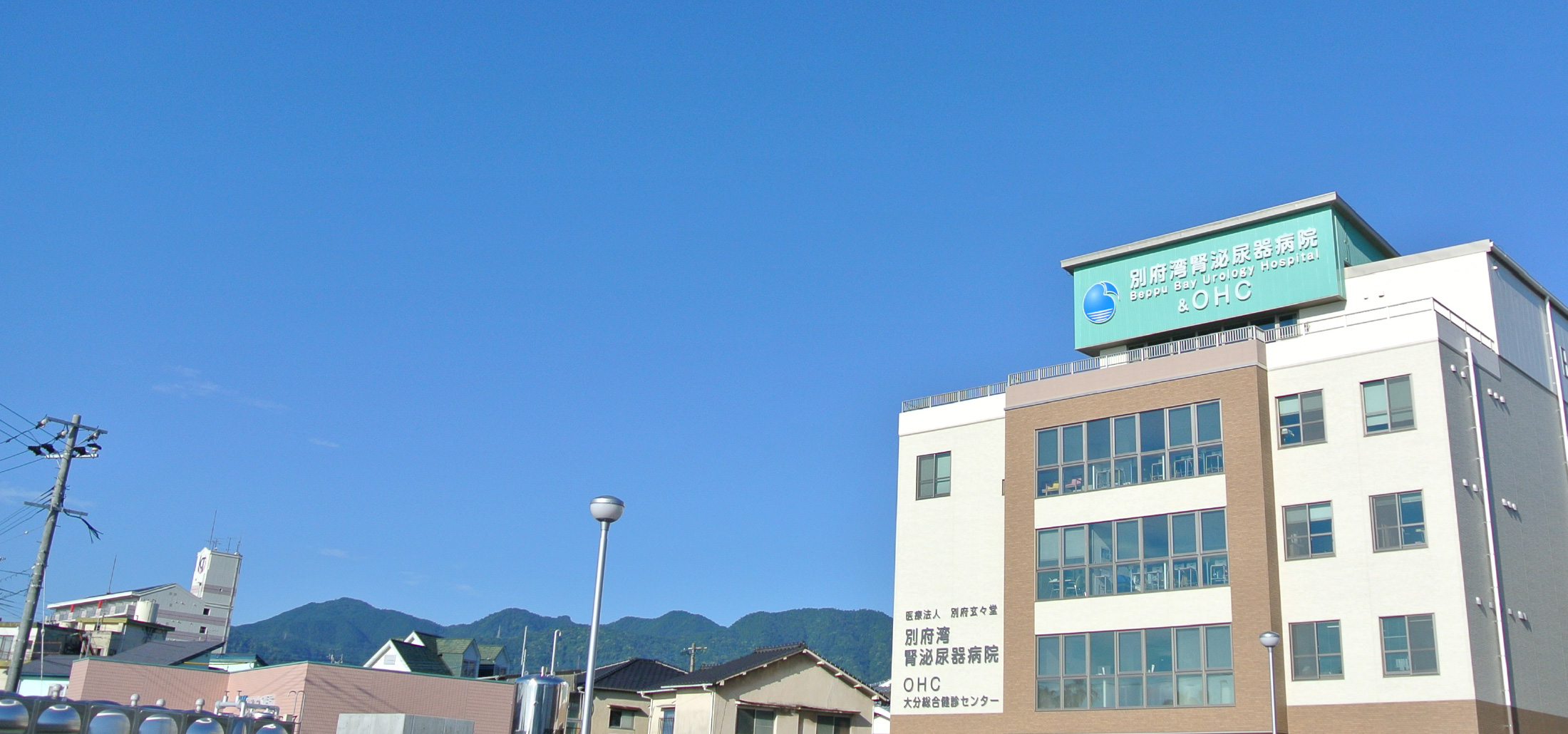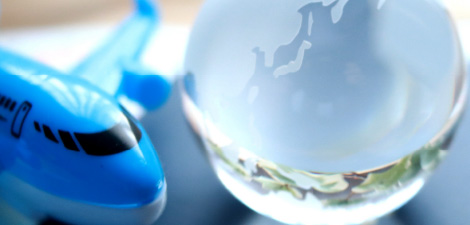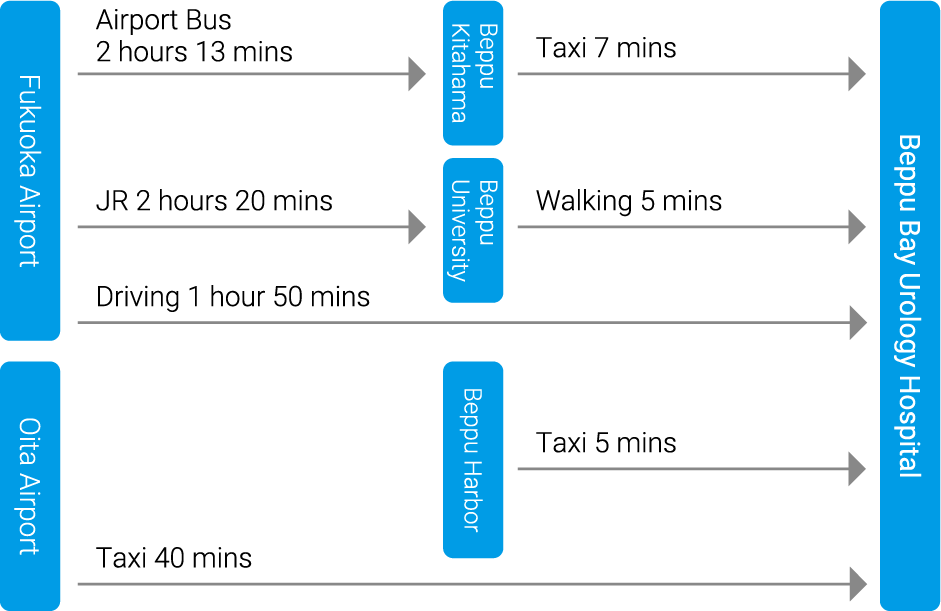Greeting from Director

Beppu Bay Urology Hospital
Director Dr. Fuminori Sato
Thank you very much for visiting our website. Our hospital opened on February 1, 2018, with a team of skilled doctors and the purpose of providing world class less invasive medical care in urology field. We provide the latest prostate cancer diagnosis methods using advanced technology such as merging MRI images and the da Vinci robotic-assisted surgical system. Additionally, we utilize 3D endoscope surgery, laser surgery, extracorporeal shock wave lithotripsy, etc., which are the most advantageous and less invasive diagnosis methodologies and treatment for our patients. Within a year and a half after opening, we have helped over 100 patients using the robotic-assisted radical laparoscopic prostatectomy procedure. Currently, we maintain one of the highest track records supporting prostate cancer diagnosis and treatment in Japan. If you suspect that you have cancer, or you have already been diagnosed with cancer, or if you are suffering from a urological disease, please feel free to contact our hospital. Our experts will provide you with the most optimal exam methods and treatment.
High precision prostate target
biopsy device TRINITY
Why do we need target biopsy ?
The only way to confirm a prostate cancer diagnosis is to collect prostate tissue. This is called “prostate biopsy”.
The collected tissue is examined with a microscope to diagnose cancer cells.
However, an accurate diagnosis cannot be made unless the tissue can be sampled at the suspicious location of the tumor during the prostate biopsy.
The cancer diagnosis depends greatly on the biopsy method.

What is the difference between
conventional and recent biopsy methods ?
> Conventional biopsy method
( Systematic biopsy ≒ Random biopsy method )
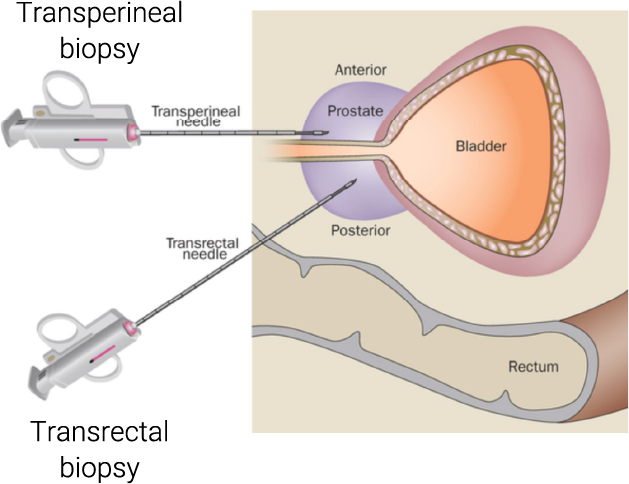
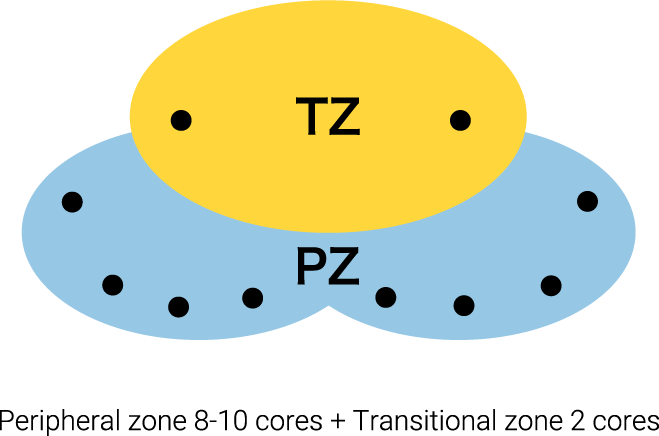
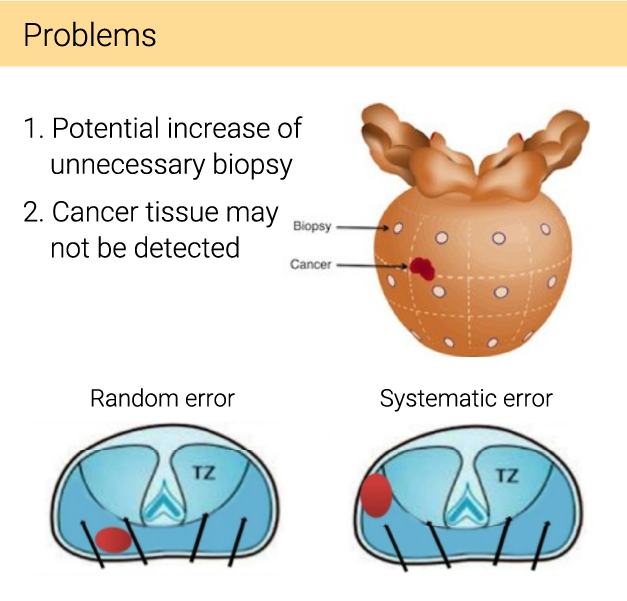
> Recent biopsy method ( Target biopsy + Systematic biopsy )
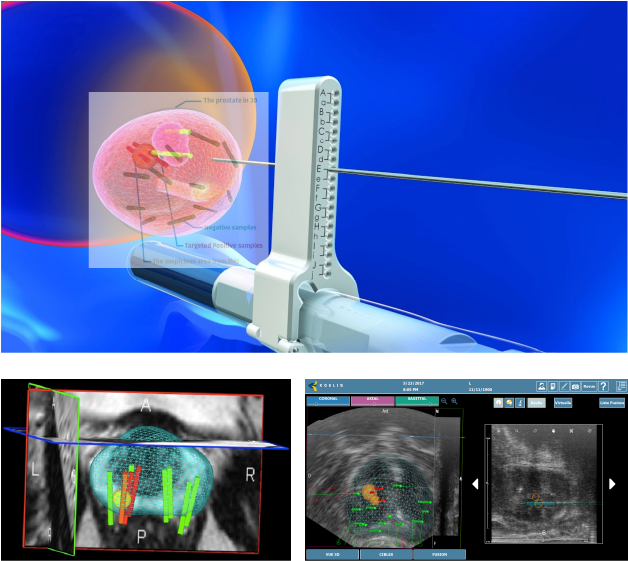
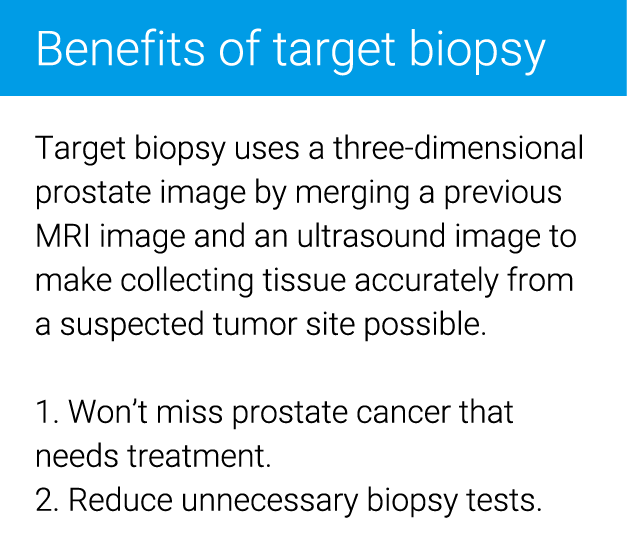

Case 1 | Single Target

Case 2 | Multiple Targets
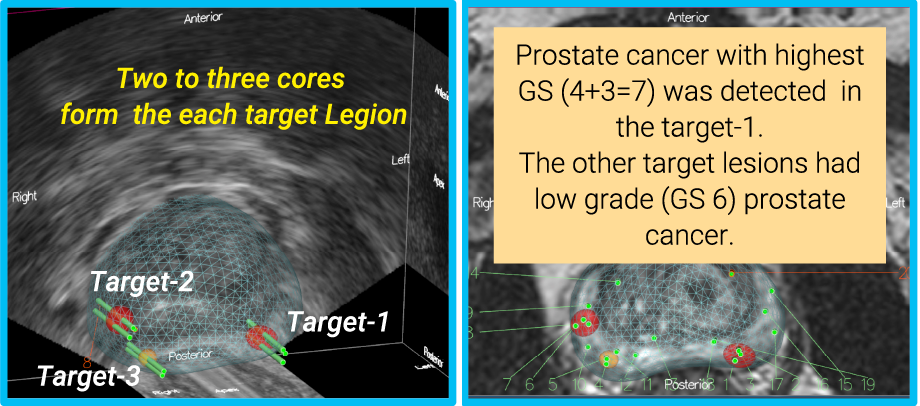
Prostate target biopsy results
【Feb. 2018~Jun. 2019】
Since our opening in February 2018, our hospital has performed prostate biopsies for over 100 patients. Based on the past results (111 cases, 157 lesions), we compared the cancer detection rates between target biopsy method and random biopsy method.
1. Comparison of target biopsy
and random biopsy

2. PI-RADS category in target biopsy *2
other cancer detection rate


*2: PI-RADS Category: MRI evaluates the possibility of prostate cancer on a 5-level scale (the higher the number is, the higher the possibility is), and if it is above 3, it is a target biopsy site indication.
As shown in the graph, target biopsy has a higher cancer detection rate than common random biopsy, and reduces risk of “missing significant cancer that needs treatment”.
Facilities with target biopsy devices
in Japan (As of July 2019)
| Biopsy method | Installed facility |
|---|---|
| Transrectal | Kyoto Prefectural University of Medicine (Kyoto) *Updated the 2nd device |
| Transrectal | Chuno Kosei Hospital (Gifu) *Update scheduled |
| Transrectal | Tokyo Dental College Ichikawa General Hospital (Chiba) |
| Transrectal | Hiroshima University (Hiroshima) |
| Transrectal | Saiseikai Shiga Hospital (Shiga) |
| Transrectal | Tottori University (Tottori) |
| Transperineal | Beppu Bay Urology Hospital (Oita) |
| Transperineal | Toyota Memorial Hospital (Aichi) |
| Biopsy method | Installed facility |
|---|---|
| Transperineal | Oita University (Oita) |
| Transperineal (Transrectal) |
Edogawa Hospital (Tokyo) |
| Transrectal | Kawasaki Medical School Hospital (Okayama) |
| Transperineal (Transrectal) |
Saitama Medical University International Medical Center (Saitama) |
| Transrectal | Iwate Prefectural Chubu Hospital (Iwate) |
| Transrectal | Kochi Takasu Hospital (Kochi) |
| Transperineal | Kyushu University (Fukuoka) |
by the European Association of Urology(EAU)
Laparoscopic surgery support robot
da Vinci
Da Vinci is a robot that supports conventional laparoscopic surgeries which require making several small incisions. The surgeons operate the robot scalpel and forceps according to the endoscope. Da Vinci is a great revolution in the world of surgery.
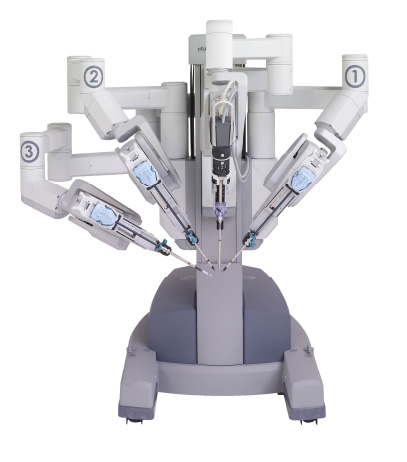
2. Less bleeding
3. Less need for narcotic
analgesics
5. Less complications
6. Faster recovery compared to open surgery
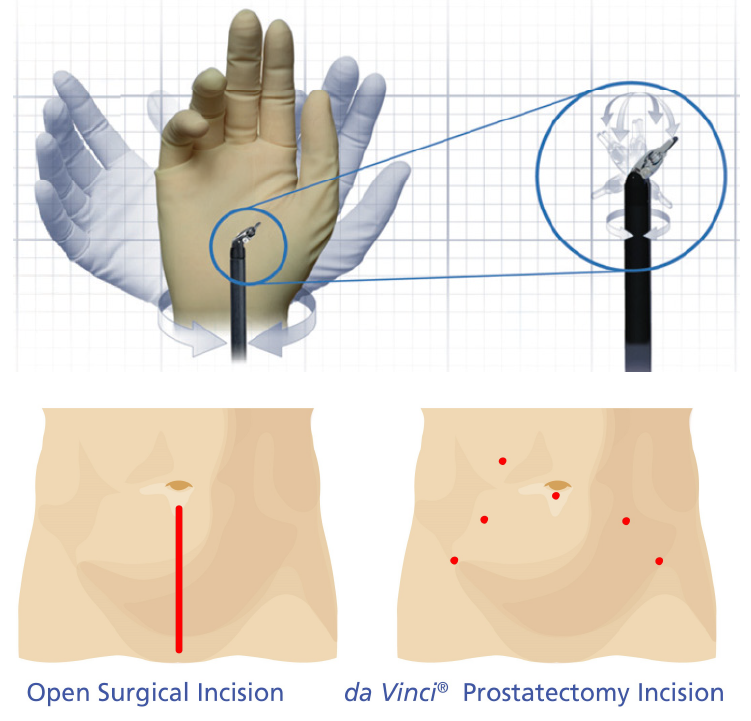
Da Vinci consists of three main components: a Surgeon console, a Patient cart, and a Vision cart.
The movements of the controller convert the movements of doctor’s hand into finer and more precise movements, making it easier to operate on deeper parts of the body. Because it operates through 4-5 1cm small open holes, it features smaller wounds and faster recovery than conventional laparotomy.


Other latest medical equipments
> Extracorporeal shock
wave
lithotripsy (ESWL)

To treat kidney and ureteral stones, ESWL provides the treatment that the patient can stay at an easy position, and can be done in a short time without surgery requirement. It concentrates shock wave energy on the stone and crushes it. The crushed stone is sand like and will be discharged naturally along with urine.
> Surgical 3D
endoscope system

Surgery is performed with a surgical endoscope inserted through several holes in the abdomen for the purpose of removing lesion area such as cancer. It is performed with the less invasive method that doesn’t require laparotomy.
>Transurethral
lithotripsy (TUL)
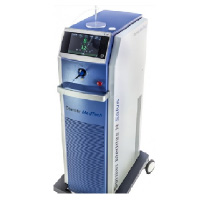
Transurethral lithotripsy can be performed with our less invasive procedure by an endoscope using a holmium YAG laser even in cases where kidney and ureteral stones are difficult to treat with ESWL alone.
>Green laser

The Green Laser is one of the less invasive treatment devices that is used for benign prostatic hyperplasia. As it can evaporate and coagulate at the same time, it causes less bleeding and less pain, and aids our patients to quickly recover after surgery.
Features・Specialists
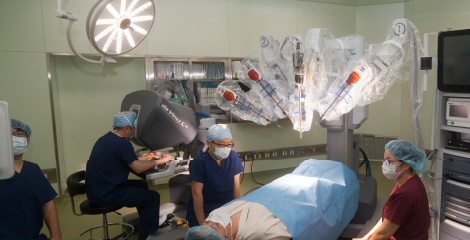
Our hospital was opened in February 2018 to conduct world-class medical care in the renal urology field. In particular, we provide “less invasive medical care” with less burden on the patient’s body through the expertise of our urology specialists.
We utilize the “KOELIS high precision prostate target biopsy device TRINITY” equipped with the first transperineal biopsy in Japan, and the laparoscopic surgery support robot “Da Vinci” that can treat prostate cancer by world standard, we provide various latest medical devices that enable less invasive.
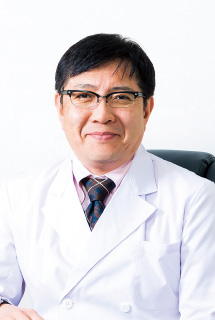
Dr. Fuminori Sato
Beppu Bay Urology Hospital Director
Tenured Professor, Oita University Faculty of Medicine Department of Renal Urology Surgery
[ Education ] Oita University Faculty of Medicine
[ Specialized・Board Certification ] Medical Doctor, The Japanese Urological Association Specialist・Supervisor, Japanese Society of Endourology Endoscopic Surgical Certified Doctor, Japan Society for Endoscopic Surgery Urology Field Certified Doctor, Japanese Board of Cancer Therapy Cancer Therapy Certified Doctor, The Japan Society for Transplantation Transplantation Certified Doctor, Japanese Society for Clinical Renal Transplantation Renal Transplantation Certified Doctor, The Japanese Society for Dialysis Therapy Certified Doctor・Supervisor
[ Academic Conference ] The Japanese Urological Association, Japanese Society of Endourology, Japan Society of Urologic Oncology, Japanese Society of Geriatric Urology, The Japanese Continence Society, Japan Society for Endoscopic Surgery, Japan Robotic Surgery Society, The Japan Society for Transplantation, Japanese Society for Clinical Renal transplantation, Japanese Cancer Association, Japan Society of Clinical Oncology, The Japanese Society for Dialysis Therapy, Japanese Society for Clinical Pathway, AUA (American Urological Association), EAU (European Urological Association), SIU (Société Internationale d’Urologie), Endourological Society [ USA ], Society of Laparoendoscopic Surgeons [ USA ]

Dr. Yasuyuki Akita
Beppu Bay Urology Hospital Department of Urology Chief
[ Education ] Oita University Faculty of Medicine
[ Specialized・Board Certification ] Medical Doctor, The Japanese Urological Association Specialist・Supervisor, Japanese Society of Pediatric Urology Certified Doctor, Japanese Society of Endourology Endoscopic Surgical Certified Doctor, Japan Society for Endoscopic Surgery Urology Field Certified Doctor
[ Academic Conference ] The Japanese Urological Association, Japanese Society of Endourology, Japanese Society of Pediatric Urology, Japan Society for Endoscopic Surgery

Dr. Hironori kai
Beppu Bay Urology Hospital Department of Urology ・ Internal medicine
[ Education ] Jichi Medical University
[ Specialized・Board Certification ] The Japanese Society of Internal Medicine Certified Doctor, Japan Primary Care Association Certified Doctor・Supervisor, Medical Residency Supervisor
[ Academic Conference ] The Japanese Urological Association, The Japanese Society of Internal Medicine, Japan Primary Care Association, The Japan Diabetes Society
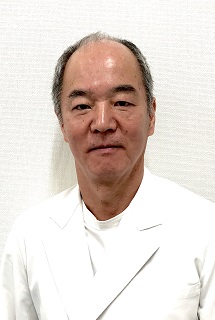
Dr. Yoshihisa Tasaki (LOCUM DOCTOR)
Medical Corporation Gengendo・Gengendo Urology Hospital Deputy Director





